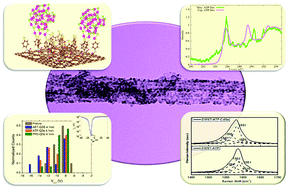Ligand-induced dependence of charge transfer in nanotube–quantum dot heterostructures†
Abstract
As a model system to probe ligand-dependent charge transfer in complex composite heterostructures, we fabricated double-walled carbon nanotube (DWNT)–CdSe quantum dot (QD) composites. Whereas the average diameter of the QDs probed was kept fixed at ∼4.1 nm and the nanotubes analyzed were similarly oxidatively processed, by contrast, the ligands used to mediate the covalent attachment between the QDs and DWNTs were systematically varied to include p-phenylenediamine (PPD), 2-aminoethanethiol (AET), and 4-aminothiophenol (ATP). Herein, we have put forth a unique compilation of complementary data from experiment and theory, including results from transmission electron microscopy (TEM), near-edge X-ray absorption fine structure (NEXAFS) spectroscopy, Raman spectroscopy, electrical transport measurements, and theoretical modeling studies, in order to fundamentally assess the nature of the charge transfer between CdSe QDs and DWNTs, as a function of the structure of various, intervening bridging ligand molecules. Specifically, we correlated evidence of charge transfer as manifested by changes and shifts associated with NEXAFS intensities, Raman peak positions, and threshold voltages both before and after CdSe QD deposition onto the underlying DWNT surface. Importantly, for the first time ever in these types of nanoscale composite systems, we have sought to use theoretical modeling to justify and account for our experimental results. Our overall data suggest that (i) QD coverage density on the DWNTs varies, based upon the different ligand pendant groups used and that (ii) the presence of a π-conjugated carbon framework within the ligands themselves coupled with the electron affinity of their pendant groups collectively play important roles in the resulting charge transfer from QDs to the underlying CNTs.


 Please wait while we load your content...
Please wait while we load your content...